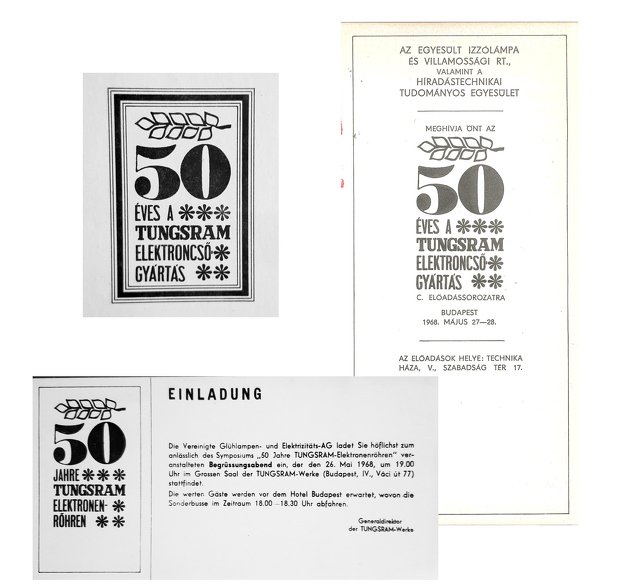In our 125th jubilee year, we wish you a happy and prosperous New Year with a short glance at our former jubilees.
History did not favor Tungsram at its first two jubilees. United Electric Ltd, the predecessor of Tungsram, was founded on August 1, 1896. In 1921, Hungary struggled to face the consequences of a lost World War, the dissolution of the Austro-Hungarian Monarchy and the shock of the Hungarian Kingdom’s substantial territorial losses. The end of the war did not bring back the ‘happy times of peace’. The years immediately after the war were marked by coal shortages, revolutions and terror, political tensions among the new successor states of the Monarchy, substantial barriers to international trade and the unsettled state of reparations. Hyperinflation led to the impoverishment of people living from salaries paid in a depreciating Hungarian currency. This was no time for festivities. In 1921, the new CEO, Lipót Aschner established a research laboratory and came to an agreement with General Electric to ensure keeping up with technological change. Tungsram prepared for growing protectionism in international trade with continuing efforts to complete vertical production and by establishing a range of sales offices and production units abroad.
On August 1, 1946 a new Hungarian currency, the forint was introduced: It was a symbolic date for a second attempt at currency stabilization after a second lost world war and a second hyperinflation in the 20th century. In February 1946, under the most dire conditions possible, the Tungsram Research Laboratory - led by Professor Zoltán Bay - performed a sensational scientific achievement when it detected the echo of radar waves they had sent to the Moon. Nevertheless, the huge personal losses suffered by Tungsram staff, the dismantling of the central factory by the Soviet Army, shortages of food, coal and electricity, the nationalization of Tungsram subsidiaries in Eastern Europe, the unsettled state of the ones in Western Europe, and the growing power of Communism backed by the presence of the Soviet Army, cast a shadow over the 50th anniversary of the establishment of Tungsram.
The 50th anniversary of starting electron tube production at Tungsram, in 1968, marked the first opportunity for festive celebration. Tungsram was among the first companies in the world to start producing electron tubes, at that time for military use, and to develop a full range of radio tube production (mostly receivers) for commercial and military use in the interwar era. The scientific symposium marking the anniversary hosted presentations by senior experts from East and West, including AEG Telefunken, ESL Esslingen and Siemens Berlin, VEB Funkwerk Erfurt and the Svetlana factory in Leningrad in addition to Hungarian experts representing the Technical University, national research institutes with close connections to Tungsram and Tungsram itself.
 Tungsram, which, led by CEO Béla Dienes,was working towards regaining its position among the most important producers of light sources, celebrated the 75th anniversary of the founding of the company with a historical exposition and a scientific symposium featuring speakers from East and West Germany, the Soviet Union and Hungarian scientific institutions.
Tungsram, which, led by CEO Béla Dienes,was working towards regaining its position among the most important producers of light sources, celebrated the 75th anniversary of the founding of the company with a historical exposition and a scientific symposium featuring speakers from East and West Germany, the Soviet Union and Hungarian scientific institutions.

In 1986, the economy of socialist Hungary was facing mounting problems stemming from increasing foreign debt, the huge energy demand of a heavy industry built to mimic the Soviet model, decreasing productivity at many large state enterprises - that is the necessity of a complete structural overhaul. Tungsram, supplier of 3-5 % of world light source production, celebrated its 90th anniversary with opening a company museum and a historical exhibition so as presentations about the contribution of Tungsram to the development of light source and radio tube production, showcasing the nearly 5 decades of its machine building range and the Tungsram products in the world. The two main Soviet partners, the Svetlana factory and the MELZ Association introduced their portfolio to the audience.

When Tungsram turned 100, Hungary had already gone through its third fundamental political transformation in the 20th century and was facing the challenge of exploiting the opportunities presented by the transition to market economy. Tungsram itself mastered this transition as a new member of the General Electric concern. At the 100th anniversary of Tungsram, which was celebrated with a scientific conference at the Hungarian Academy of Sciences, the company was already sole producer of innovative energy saving products such as compact fluorescent lamps for GE Lighting worldwide and its research team played a key role in research for GE Lighting.
The year marking the company’s 125th anniversary brought along its own challenge, that of short-term economic crisis, worldwide supply chain disruptions and enfolding long-term economic and social consequences due to the COVID pandemic. Following the transformation of the global lighting industry and the beginning of the fifth industrial revolution, Tungsram itself is in a transformation, transiting from a light source producer to a company providing complex projects in the field of smart solutions, smart cities and indoor farming while strengthening its core lighting business.
We wish you all a happy and successful New Year!


 Tungsram, which, led by CEO Béla Dienes,was working towards regaining its position among the most important producers of light sources, celebrated the 75th anniversary of the founding of the company with a historical exposition and a scientific symposium featuring speakers from East and West Germany, the Soviet Union and Hungarian scientific institutions.
Tungsram, which, led by CEO Béla Dienes,was working towards regaining its position among the most important producers of light sources, celebrated the 75th anniversary of the founding of the company with a historical exposition and a scientific symposium featuring speakers from East and West Germany, the Soviet Union and Hungarian scientific institutions.
